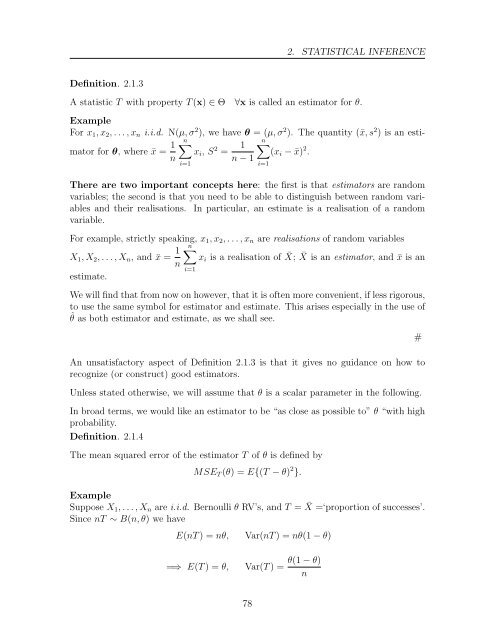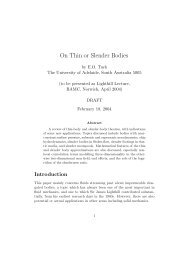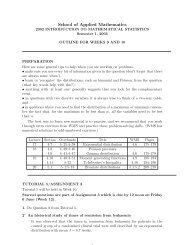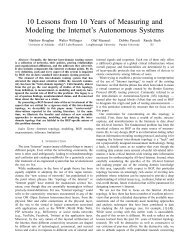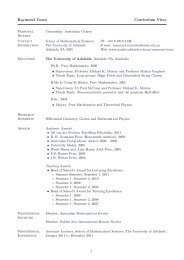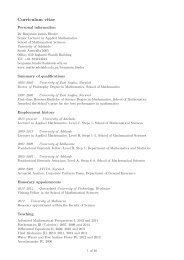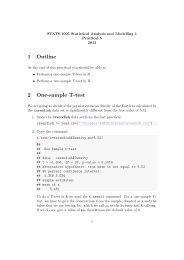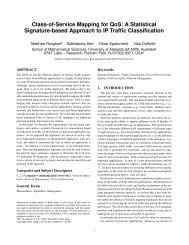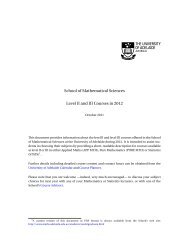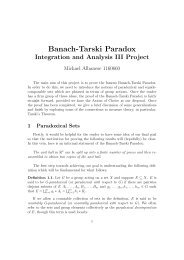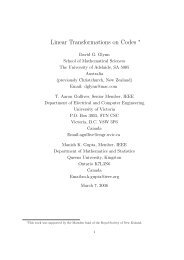PDF of Lecture Notes - School of Mathematical Sciences
PDF of Lecture Notes - School of Mathematical Sciences
PDF of Lecture Notes - School of Mathematical Sciences
Create successful ePaper yourself
Turn your PDF publications into a flip-book with our unique Google optimized e-Paper software.
2. STATISTICAL INFERENCE<br />
Definition. 2.1.3<br />
A statistic T with property T (x) ∈ Θ ∀x is called an estimator for θ.<br />
Example<br />
For x 1 , x 2 , . . . , x n i.i.d. N(µ, σ 2 ), we have θ = (µ, σ 2 ). The quantity (¯x, s 2 ) is an estimator<br />
for θ, where ¯x = 1 n∑<br />
x i , S 2 = 1 n∑<br />
(x i − ¯x) 2 .<br />
n<br />
n − 1<br />
i=1<br />
There are two important concepts here: the first is that estimators are random<br />
variables; the second is that you need to be able to distinguish between random variables<br />
and their realisations. In particular, an estimate is a realisation <strong>of</strong> a random<br />
variable.<br />
For example, strictly speaking, x 1 , x 2 , . . . , x n are realisations <strong>of</strong> random variables<br />
X 1 , X 2 , . . . , X n , and ¯x = 1 n∑<br />
x i is a realisation <strong>of</strong> ¯X; ¯X is an estimator, and ¯x is an<br />
n<br />
estimate.<br />
i=1<br />
We will find that from now on however, that it is <strong>of</strong>ten more convenient, if less rigorous,<br />
to use the same symbol for estimator and estimate. This arises especially in the use <strong>of</strong><br />
ˆθ as both estimator and estimate, as we shall see.<br />
An unsatisfactory aspect <strong>of</strong> Definition 2.1.3 is that it gives no guidance on how to<br />
recognize (or construct) good estimators.<br />
Unless stated otherwise, we will assume that θ is a scalar parameter in the following.<br />
In broad terms, we would like an estimator to be “as close as possible to” θ “with high<br />
probability.<br />
Definition. 2.1.4<br />
The mean squared error <strong>of</strong> the estimator T <strong>of</strong> θ is defined by<br />
i=1<br />
MSE T (θ) = E{(T − θ) 2 }.<br />
Example<br />
Suppose X 1 , . . . , X n are i.i.d. Bernoulli θ RV’s, and T = ¯X =‘proportion <strong>of</strong> successes’.<br />
Since nT ∼ B(n, θ) we have<br />
E(nT ) = nθ, Var(nT ) = nθ(1 − θ)<br />
#<br />
=⇒ E(T ) = θ, Var(T ) =<br />
θ(1 − θ)<br />
n<br />
78


